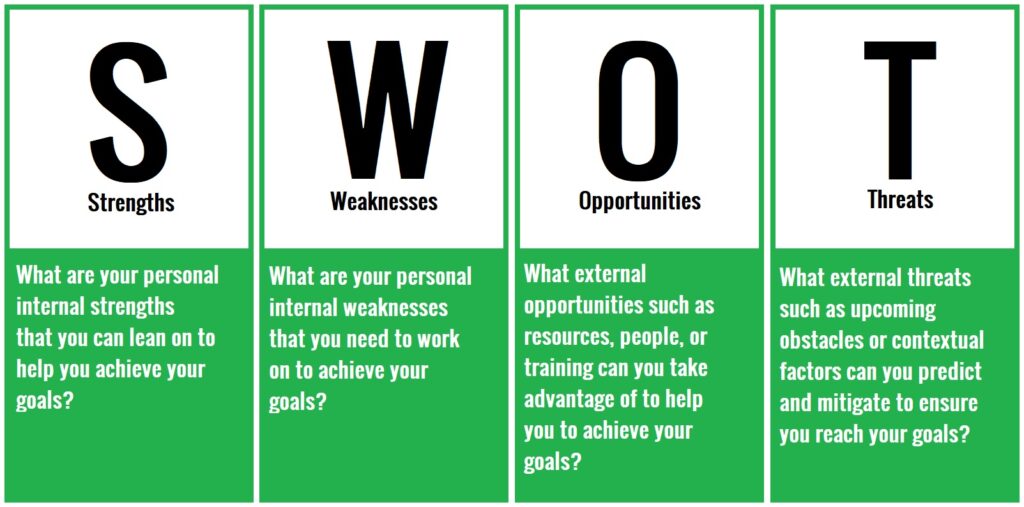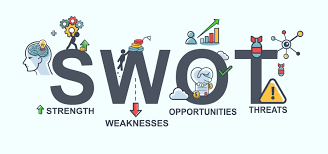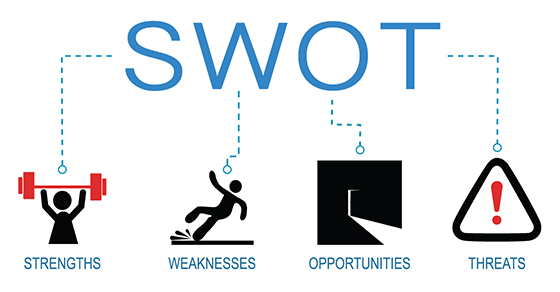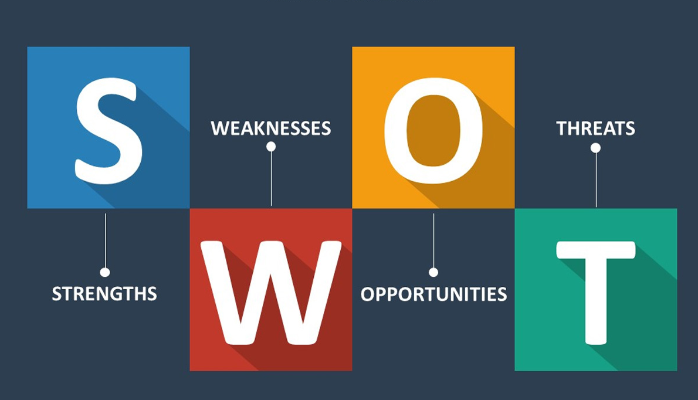A SWOT analysis tool is one of the most effective business and decision-making tools. SWOT analysis can help you identify the internal and external factors affecting your business.
A SWOT analysis helps you:
- build on strengths (S)
- minimise weakness (W)
- seize opportunities (O)
- counteract threats (T).
The results generated by a SWOT analysis makes up part of your business planning. It can also help you to:
- better understand your business
- identify areas of the business that need improving
- decide if you should introduce a new product or service
- understand your market and competitors
- predict changes you will need to deal with to ensure your business is successful.

Using SWOT analysis in your business
You should consider doing a SWOT analysis to give you a framework for understanding the state of your business and where you have opportunities for growth or fixing any faults in your operation.
To conduct a SWOT analysis, you must look at both the internally and externally focused activities of your business.
Internal Focus
Internally focused activities are matters generally under the business’s control, including:
- internal operations
- marketing and sales
- financial management
- staffing and human resources
- customer service
- quality assurance.
You can use the SWOT analysis tool (see below) to identify current strengths and weaknesses in your internally focused activities.
To assist your analysis, consider:
- conducting quarterly internal reviews
- brainstorming with your team
- checking business processes
- tracking business performance and metrics.
External Focus
Externally focused activities are the activities that affect your business but are generally outside its control, including:
- supplier operations
- tenders and grants
- competitors
- politics
- the social and natural environment
- global trade
- financial markets.
You can use the SWOT analysis tool (see below) to identify opportunities and threats for externally focused activities.
To assist your analysis, you might also consider:
- researching trends, reports and industry data
- reading newspapers and journals
- working with mentors and advisers
- attending business events and conferences
- meeting with suppliers and government
- attending research tours of other states and countries.

Reasons for using SWOT Framework
You can use a SWOT analysis to help you review your entire business, but you can conduct an analysis focusing on 1 or 2 specific issues.
SWOT analysis can:
- help you create or update your business plan
- help you decide whether to introduce a new product or service to the market
- be part of your regular strategic planning review (quarterly, half-yearly or yearly).
A SWOT analysis should generate a brief list of issues relevant to the 4 categories—strengths, weaknesses, opportunities and threats.
The analysis of these issues helps the business make meaningful changes. For example, if the SWOT analysis has indicated a staffing weakness, a more detailed human resourcing plan may be required.
Limitations of SWOT
A SWOT analysis is not a perfect tool—it has some limitations.
A SWOT analysis:
- will not prioritise issues—it must be reviewed to produce meaningful results
- will not provide solutions or offer alternative decisions—you must look at the issues noted and work to generate solutions
- can generate too many ideas but will not help you choose which one is best—when this occurs, try to limit the scope of the analysis to only a few solutions
- can produce a lot of information, but it may not all be useful—you must review the data generated to determine what is relevant.

Tips for Successful SWOT Analysis
A SWOT analysis helps you assess internal factors that might affect your business (strengths and weaknesses) and external factors (opportunities and threats).
You will need to review and act on the results from the SWOT analysis.
The following tips can help ensure your SWOT analysis is successful:
- Keep your SWOT analysis short and simple, but remember to include key details. For example, if you think your staff are a strength, have specific information about individual staff and their specific skills and experience, as well as why they are a strength and how they can help you meet your business goals.
- Get multiple perspectives on your business—ask for input from your employees, suppliers, customers and partners, and review online reviews and feedback.
- Make sure the focus of the SWOT analysis is not too narrow. While it can help to complete SWOT analyses on specific issues (e.g. a quarterly goal for growing your customer base), having an overall business SWOT analysis is always helpful.
- Ensure that you link the SWOT analysis back to your business plan—you should refer to the defined goals and objectives in the business plan when considering the issues identified.
- Make sure you capture and document the findings of your SWOT analysis in your business plan
Building STRENGTHS
The SWOT analysis tool can be used to identify existing strengths and build on them.
Consider the following:
- What does the business do well?
- What is your competitive advantage? Could it be increased or transferred to more customer types?
- What internal strengths does your business have? Consider skills, knowledge, networks and reputation.
- What external strengths does your business have? Consider customers, technology, funding and capital.
- How can the business build on its strengths?
- What skills and training do you and your staff have? Are you making the best use of them?
- Are you making the best use of your digital technology? Could you upgrade or expand them to improve your business?
- What other strengths can you identify and use more effectively?

Minimizing your WEAKNESSES
The SWOT analysis tool should be used to identify and limit weaknesses in your business.
Consider the following:
- What are the weaknesses of your systems and processes?
- What processes, policies or procedures could be developed to minimise the effects of these weaknesses?
- Are there weaknesses in your business model? Could you change 1 or more components of your model to improve the business? Search online for business model mapping tools online to help you visualise and update your business model.
- Could you improve staff selection, job descriptions, performance and mentoring?
Seizing OPPORTUNITIES
The SWOT analysis tool can be used to identify and explore opportunities. Opportunities are the external factors that, if used effectively, can help you build your competitive advantage.
Consider the following:
- What are the current industry trends (e.g. a new online channel to market products and services)? Can they be used to your advantage?
- Are there any upcoming changes that could positively affect your business? Consider, for example, consumers, regulation and technological advancements.
- Is the business eligible for any grants or tenders?
- Are there new market opportunities that you could consider? Learn about the basics of exporting.
Counteracting THREATS
The SWOT analysis tool will help you to identify and counteract threats and build resilience. Threats include external factors that may be beyond your control.
Consider the following:
- What external factors could put the business at risk?
- What factors might affect the business?
- What new competitors may enter your market? How could this affect your business?
- What risk-management strategies do you have in place and could they be improved?
- What tools do you have to build resilience to manage and mitigate risks?

What to do after completing a SWOT
After you’ve compiled your SWOT data, complete an analysis by:
- selecting a maximum of 3–5 issues from each quadrant in the SWOT tool
- prioritising the issues.
- creating an action plan to deal with each issue, including identifying
- the people responsible for solving the issue
- the necessary resources and budget
- the timeframes for completion and review.
Note that the same issues may appear in different quadrants—for example, some identified opportunities may help overcome a weakness or build on an identified strength within the business. Occasionally, a SWOT analysis may identify a threat that prompts a change in the business model.
You should regularly review the action plans you have in place to ensure that any connections between issues are handled and actions are coordinated across the business.
You must also consider the constantly changing external and internal business environments. Conduct regular SWOT analyses to ensure you are prepared for these changes and can build on your business’s strengths for success.

































